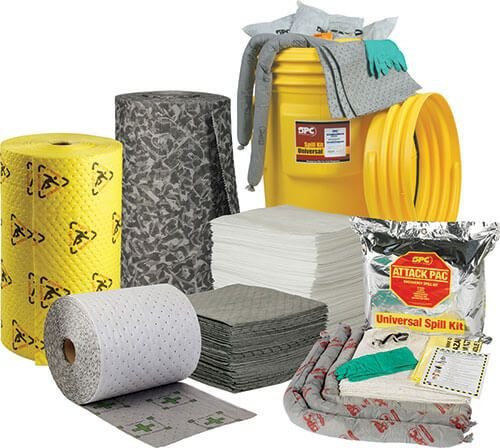Sorbent & How Do Sorbents Work
5 min readSpills and leaks in the workplace can have far-reaching consequences for both workers and the environment. Hydrocarbon fuels such as diesel, propane, and gasoline are some of the most common irritants found in many facilities. When exposed to air, the vapors can irritate the eyes and damage the lungs if inhaled. Fluids such as coolant and oils can make floors slick and slippery, while seepage can contaminate the surrounding soil and cost thousands of dollars in fines.
Spills and leaks can be unpredictable. So, we put together this guide to help you better understand whats is a sorbent and how to choose the right sorbents for your needs, so that your response to spills doesn’t have to be.

Not All Spills Are Alike
In most facilities, the potential for a spill is not a matter of if, but rather a matter of what, where, when, and how. Identifying the types of fluids stored in your facility will help you determine the best products to use. Most spills fall into one of three categories:
Universal Spills consist of water-based chemicals and solvents. These non-aggressive spills are the most common, and spill control products containing cellulose and other water-absorbent materials work best.
Oil/Petroleum Spills are substances that consist of hydrophobic hydrocarbons (such as diesel, gasoline, and butane). They tend to cluster while repelling water. Oil-only spill control products are designed to repel water and adsorb oil.
Chemical Spills consist of aggressive substances such as acids and bases. They require special synthetic sorbents found in chemical spill kits that can withstand corrosion.
What is Adsorbent and Absorbent: Do You Know the Difference?
Sorbents are designed to either absorb or adsorb. Sounds simple, but it makes a big difference depending on the type of fluid you are trying to clean up! For instance, many universal sorbents contain cellulose, which is a vegetable-based pulp, kind of like cotton. This is great for soaking up water-based liquids and even some oils, but acids and bases will eat right through it, and denser oils will sit on the surface without penetrating the media. When it comes to these two processes, here’s what you need to know:
What is Absorption?
When a liquid is absorbed, it assimilates into the media. In order for that to happen, the liquid molecules must be small enough to dissolve into the material, as an absorbent pillow or pad. This is why denser oils and cellulose don’t mix – the oil molecules are too big and cellulose is too dense.
How Does Adsorption Work?
When a liquid is adsorbed, it sticks to the surface of the media. This means that sorbents that pick up oils need to have more surface area. Polypropylene works well for this because the fibers help attract oils to their surface.
Types of Sorbents
Type, volume, and location all determine what kind of sorbents to use in order to control, contain, and clean a spill. Here are the most common sorbents and their applications:
What are absorbent pads?
Pads and rolls are designed for extended use and can be durable enough to accommodate foot, as well as equipment traffic. They are ideal for areas that commonly experience incidental spills or leaks such as aisles and walkways, or underneath equipment.
Many pads and rolls feature non-slip surfaces and are even available in patterned prints to hide stains. Anti-fatigue absorbent pads can be used in areas where workers spend the majority of their time standing. Rolls come in perforated sheets that can be cut to size allowing you to only use as much as you need.
What are absorbent pillows?
Pillows contain media that allows them to soak up large amounts of fluid. They can be molded to fit into tight corners and spaces or placed on top of a spill that has already been contained with a sock or boom. Depending on the type of spill the pillow is designed for, it may contain cellulose for universal spills or polypropylene for oils, acids, and bases.
What are absorbent socks?
Socks are one of the most versatile absorbent products you can have in your spill control kit. Their length allows them to be placed around leaking equipment and tanks, or they can be used to protect grates and contain spills of just about any size. Socks can also be molded to fit into corners and work well on uneven surfaces
What are loose sorbents?
Loose Sorbents can be made out of organic or synthetic materials. These work well for small cracks and crevices, soil, or as the final step in your clean-up procedure to remove the oil sheen from floors and other surfaces.
What to Look for When Selecting a Sorbent
Whether you work with cooking oil or corrosive chemicals, determining your sorbent needs comes down to more than just the types of fluids stored in your facility. You’ll also want to consider capacity, application, storage, and disposal. Here’s what that means for you:
Capacity – when a sorbent becomes saturated, it loses its ability to continue soaking up fluid. Over-saturated sorbents can release their contents when lifted, causing possible secondary contamination. Requirements for calculating sorbent capacity vary by city, state, and whether your facility must comply with the SPCC rule.
Application – Sorbents come in many application types. Some are designed to float on top of the water or cover a large surface area for big spills. Others might consist of loose materials and require a fan or blower for application.
Storage – How your spill control products are stored may determine their effectiveness later on. For instance, many oil-only sorbents have a UV coating that deteriorates when exposed to sunlight, making them less effective when they are needed. Most spill control kits come packed in their own storage container, which can be a good solution if you don’t already have a cool, dark, dry place to store your sorbents.
Disposal – Whether a sorbent is suitable for many uses or one-time use, you will eventually need to dispose of it. How you dispose of used sorbents depends on the type of liquid it contains. Some sorbents can be incinerated, while others may require hazardous waste removal. Sorbent disposal varies on state and local levels, so it is best to check local, state, and federal regulations regarding the disposal of used sorbents before you ever have to use them.
Along with properly trained employees, having the right sorbents on hand can help you increase the effectiveness of your spill control plan.



